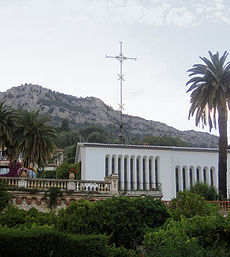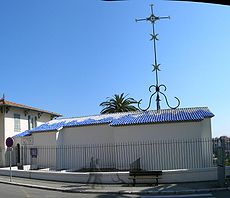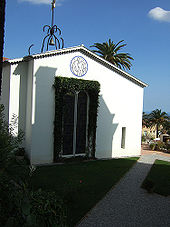
Chapelle du Saint-Marie du Rosaire
Encyclopedia



Rosary
The rosary or "garland of roses" is a traditional Catholic devotion. The term denotes the prayer beads used to count the series of prayers that make up the rosary...
), often referred to as the Matisse Chapel or the Vence Chapel, is a small chapel built for Dominican
Dominican Order
The Order of Preachers , after the 15th century more commonly known as the Dominican Order or Dominicans, is a Catholic religious order founded by Saint Dominic and approved by Pope Honorius III on 22 December 1216 in France...
nuns in the town of Vence on the French Riviera
French Riviera
The Côte d'Azur, pronounced , often known in English as the French Riviera , is the Mediterranean coastline of the southeast corner of France, also including the sovereign state of Monaco...
. It was built and decorated between 1949 and 1951 under a plan devised by Henri Matisse
Henri Matisse
Henri Matisse was a French artist, known for his use of colour and his fluid and original draughtsmanship. He was a draughtsman, printmaker, and sculptor, but is known primarily as a painter...
. It houses a number of Matisse originals and was regarded by Matisse himself as his "masterpiece." While the simple white exterior has drawn mixed reviews from casual observers, many regard it as one of the great religious structures of the 20th century.
Background
In 1941, Matisse, who lived most of the year in Nice in the south of FranceFrance
The French Republic , The French Republic , The French Republic , (commonly known as France , is a unitary semi-presidential republic in Western Europe with several overseas territories and islands located on other continents and in the Indian, Pacific, and Atlantic oceans. Metropolitan France...
, developed cancer
Cancer
Cancer , known medically as a malignant neoplasm, is a large group of different diseases, all involving unregulated cell growth. In cancer, cells divide and grow uncontrollably, forming malignant tumors, and invade nearby parts of the body. The cancer may also spread to more distant parts of the...
and underwent surgery. During the long recovery he was particularly helped by a young part-time nurse, Monique Bourgeois, who had answered his ad seeking "a young and pretty nurse" and who took care of Matisse with great tenderness. Matisse asked her to pose for him, which she did, and several drawings and paintings exist. In 1943 Monique decided to enter the Dominican convent in Vence, a nearby hill town to Nice, and she became Sister Jacques-Marie. Matisse eventually bought a home at Vence, not far from the convent where the young nun was stationed. She visited him and told him of the plans the Dominicans had to build a chapel beside the girls' high school which they operated in Vence. She asked Matisse if he would help with the design of the chapel. He had never done anything like it, but Matisse agreed to help, beginning in 1947. Father Marie-Alain Couturier
Marie-Alain Couturier
Père Marie-Alain Couturier, known as Father Couturier was a Dominican friar, designer of stained glass windows, famous for his modern inspiration of Sacred art.-Life:...
, who collaborated on several artistic Catholic churches after World War II, was also involved in the project.
At the age of 77, Matisse began the greatest project of his life and spent more than 4 years working on the chapel, its architecture, its stained glass windows, its interior furnishings, its murals, and the vestments of the priests. It is perhaps the greatest ensemble artwork of the 20th century, and certainly the greatest religious commission. While Matisse had been baptized a Catholic
Catholic
The word catholic comes from the Greek phrase , meaning "on the whole," "according to the whole" or "in general", and is a combination of the Greek words meaning "about" and meaning "whole"...
, he had not practiced the religion for many years. He designed the chapel as an artistic challenge.
The story of the friendship and collaboration of Matisse and Sister Jacques Marie is related in her 1992 book Henri Matisse: La Chapelle de Vence (ISBN 2909767000) and in the 2003 documentary Model for Matisse. Sister Jacques Marie died in 2004, aged 84.
The Architecture of the Chapel
The chapel is built on a hillside and one enters by descending a flight of stairs, and then turning to the right. The chapel is in an L shape, with the longer portion directly inside the door. The altar is placed at an angle where the two legs of the L join. The chapel is 15 meters long by 6 meters wide. The longer/larger segment is for the students or townspeople; the shorter section was for the nuns who lived and taught at the school. Both sides face the altar.Furnishings of the Chapel
The altar is made of warm brown stone, chosen for its resemblance to the color of bread and the EucharistEucharist
The Eucharist , also called Holy Communion, the Sacrament of the Altar, the Blessed Sacrament, the Lord's Supper, and other names, is a Christian sacrament or ordinance...
. Matisse also designed the bronze crucifix on the altar, the candle holders in bronze, and the small tabernacle. The wrought iron candle holder with a flame always burning and hanging from the ceiling was made by local craftsmen who have a special tradition of making wrought iron.
Stained Glass Windows
There are three sets of stained glass windows, upon which Matisse spent a great deal of time. All three sets make use of just three colors: an intense yellow for the sun, an intense green for vegetation and cactus forms, and a vivid blue for the Mediterranean SeaMediterranean Sea
The Mediterranean Sea is a sea connected to the Atlantic Ocean surrounded by the Mediterranean region and almost completely enclosed by land: on the north by Anatolia and Europe, on the south by North Africa, and on the east by the Levant...
, the Riviera sky and the Madonna. The two windows beside the altar are named the "Tree of Life," but the forms are abstract. The color from the windows floods the interior of the chapel, which is otherwise all white.
Three Great Murals
For the walls, Matisse designed three great murals to be made by painting on white tiles with black paint and then firing the large sections of tile. Each tile measures 12 in.2. Matisse was so crippled with ailments by this time that he could only work from a wheelchair, and he had a long stick with a brush strapped to his arm and pieces of construction paper placed on the wall. He then drew the images, which were transferred to tiles by skilled craftsmen.St. Dominic
Behind the altar is a large image of St. Dominic, founder of the Order of DominicansDominican Order
The Order of Preachers , after the 15th century more commonly known as the Dominican Order or Dominicans, is a Catholic religious order founded by Saint Dominic and approved by Pope Honorius III on 22 December 1216 in France...
and by tradition founder of the practice of the rosary for Catholics. He was a 13th century wandering preacher from Spain
Spain
Spain , officially the Kingdom of Spain languages]] under the European Charter for Regional or Minority Languages. In each of these, Spain's official name is as follows:;;;;;;), is a country and member state of the European Union located in southwestern Europe on the Iberian Peninsula...
. His followers wear a white garment, or habit, with a white scapular
Scapular
The term scapular as used today refers to two specific, yet related, Christian Sacramentals, namely the monastic and devotional scapulars, although both forms may simply be referred to as "scapular"....
hanging straight down the front. The simplest but most powerful of lines was created by Matisse to depict the saint.
Virgin and Child
On the side wall there are abstract images of flowers and an image of the Madonna and Child, all created in black outlines on the white tiles. Rather than clasping the child to herself, as she is usually depicted, Matisse chose to show Mary offering her son to the whole world.Stations of the Cross
On the back wall of the chapel are the traditional 14 stations of the cross. Although the 14 stations are usually depicted individually, Matisse incorporated all of them on one wall in one cohesive composition. The series begins at the bottom left as JesusJesus
Jesus of Nazareth , commonly referred to as Jesus Christ or simply as Jesus or Christ, is the central figure of Christianity...
is brought before Pilate and condemned. The stations follow Jesus' progress carrying the cross. At the top in the center are the three most powerful images - The Raising of the Cross with Jesus' body nailed to it, the actual Crucifixion
Crucifixion
Crucifixion is an ancient method of painful execution in which the condemned person is tied or nailed to a large wooden cross and left to hang until dead...
, and then Taking the Body of Jesus Down. The center panel has a straight vertical and horizontal composition, while the two surrounding stations have strong diagonal lines leading to the head of Jesus on the cross.
Sets of Vestments
Matisse also designed the priests' vestments for the chapel, using the traditional ecclesiastical colors of the religious seasons: purple, black, pink/rose, green, and red. The PopePope
The Pope is the Bishop of Rome, a position that makes him the leader of the worldwide Catholic Church . In the Catholic Church, the Pope is regarded as the successor of Saint Peter, the Apostle...
requested that the nuns send the vestments to Rome
Rome
Rome is the capital of Italy and the country's largest and most populated city and comune, with over 2.7 million residents in . The city is located in the central-western portion of the Italian Peninsula, on the Tiber River within the Lazio region of Italy.Rome's history spans two and a half...
to be put in the Vatican
Vatican City
Vatican City , or Vatican City State, in Italian officially Stato della Città del Vaticano , which translates literally as State of the City of the Vatican, is a landlocked sovereign city-state whose territory consists of a walled enclave within the city of Rome, Italy. It has an area of...
's new museum of modern religious art. The nuns made copies of five of the sets of vestments, including chasuble, maniple, stole, and covering of the chalice, and sent them to Rome.
Remainder of Chapel Area
The outside of the chapel is white. The top of the roof is decorated with a blue-and-white zigzag pattern and carries an elaborate metal cross with a bell.There is a small gift shop associated with the chapel where visitors may purchase postcards and other mementos of the chapel; income goes to support the nuns and the chapel. There are also two doors in carved wood, designed by Matisse, for the confessionals. Along the hallway to the gift shop are photos of Matisse designing the chapel. There are also some of Matisse's original sketches for the Stations and vestments.
Maquettes for all the vestments made, as well as for a number never actualized, were made by Matisse on brown wrapping paper and black construction paper. They can be seen in the Pompidou Center in Paris.
The high school has been closed for a number of years, and only a few elderly nuns still live there.
External links
- Official site, with opening hours, photographs, etc.
- Photographs of the interior and exterior of the building, from the Musée Matisse Nice
- Photographs of sketches and chasubles, from the Musée Matisse Nice
- Red Chasuble, from MOMAMomaMoma may refer to:* Moma , an owlet moth genus* Moma Airport, a Russian public airport* Moma District, Nampula, Mozambique* Moma River, a right tributary of the Indigirka River* Google Moma, the Google corporate intranet...
- Chapelle du Rosaire, by Alice Barber, AMB Cote d'Azur

